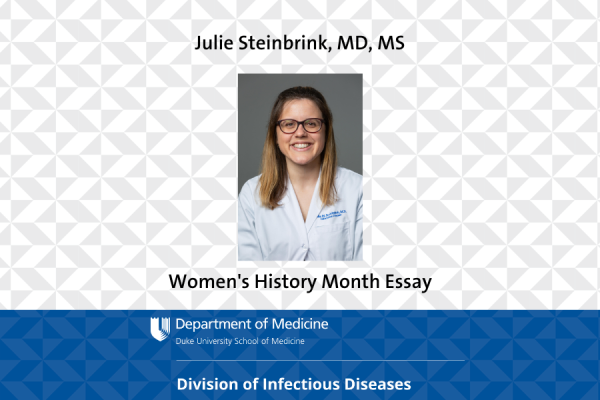
Women's History Month is a time for learning about the past and looking to the future. These essays reflect a sub-theme of the challenges women in medicine still face today - and what they are grateful for in their professional journeys. While we celebrate the women of medicine in March, listening to their voices helps us all better understand ourselves and how we can all make a difference in the struggle for equality. Our faculty member, Dr. Julie Steinbrink was asked to participate. Here is her essay:
We Continue to Encounter Significant Struggles

By Julie Steinbrink, MD, MHS
Assistant Professor, Infectious Diseases
While women in medicine today are fortunate in many ways compared to previous generations, we continue to encounter significant struggles. One obstruction that persists to varying degrees is a decreased level of overall respect given to women physicians compared to men. Published studies (and personal experience) demonstrate that women are less likely than men to be addressed by their title as doctor – instead addressed by their first name, both by patients as well as when introduced at medical conferences by colleagues. Many women physicians can also relate to the experience of entering a clinical room and being mistaken for an ancillary provider. These may sound like small slights, but when encountered frequently enough over a prolonged period, these events contribute to overall career discontentment, imposter syndrome, and physician burnout.
Furthermore, as a new mother, I have become acutely aware of the challenges of balancing a family with a career in medicine and how this disproportionately impacts women. This starts with the ubiquitous question of when the ‘optimal’ time for childbearing is in one’s medical career (spoiler alert, there isn’t one). Later, even in two-career households, women often cover most dependent care/household responsibilities and are perceived to be the primary caregiver. Personally, though my spouse is listed as the ‘first call’ at my child’s daycare due to his more flexible (non-medicine) work schedule, I am still (as the mom) always the first parent they contact with an issue or question.
Furthermore, a potent concern for me and many women in academic medicine is the stress of keeping up with research productivity and ongoing caregiving needs (whether they be childcare, eldercare, or other). Many women may be required to make up clinical work after returning from parental leave, diminishing their ability to focus on research or other scholarly pursuits. This added pressure is combined with additional published gender disparities in research, including discrepancies in authorship and funding acquisition. An inability to pursue scholarly work incites further tension regarding the downstream impact this has on promotion timelines and career advancement.
The balance of caregiving needs with the tenure clock is particularly anxiety-inducing to junior faculty who are only starting to climb the academic ladder. It can feel disheartening for such faculty to not see women in senior and leadership roles, as ‘you can’t be what you can’t see.’ Though women now make up half or more of medical school classes, and the number of women at all faculty ranks has increased over time, we remain disproportionately under-represented at higher career ranks or as division/departmental heads.
These examples, among others, are only a sampling of some of the challenges women in medicine encounter today, and some of the many reasons why ongoing work is necessary to achieve further gender parity in medicine.